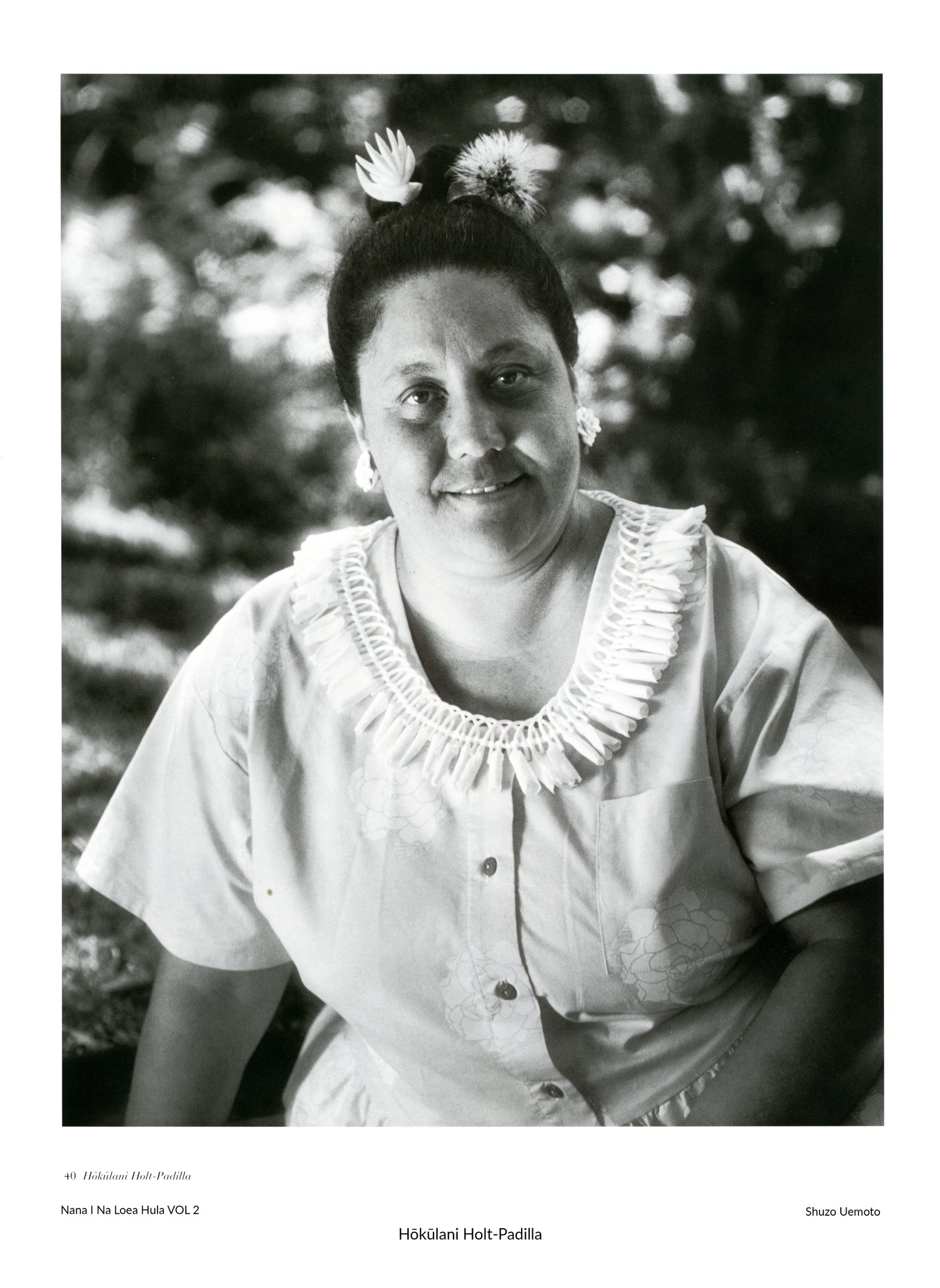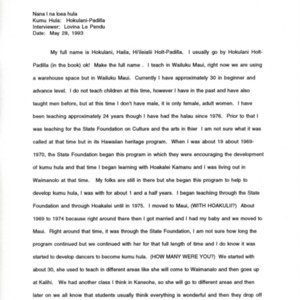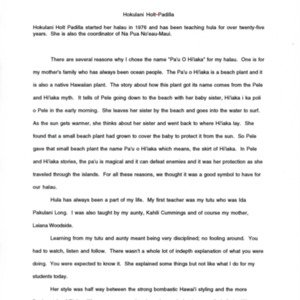Hōkūlani Holt-Padilla
Title
Hōkūlani Holt-Padilla
Subject
Nā Kumu Hula Hōkūlani Holt-Padilla - Nānā I Nā Loea Hula Volume 2 Page 41
Description
Hōkūlani Holt-Padilla started her hālau in 1976 and has been teaching hula for over twenty-five years. She is also the coordinator of Nā Pua No‘eau-Maui.
There are several reasons why I chose the name Pā‘ū O Hi'iaka for my hālau. One is for my mother’s family who have always been ocean people. The Pā‘ū O Hi'iaka is a beach plant and it is also a native Hawaiian plant. The story about how this plant got its name comes from the Pele and Hi'iaka myth. It tells of Pele going down to the beach with her baby sister Hi‘iaka-i-ka-poli-o-Pele in the early morning. She leaves her sister by the beach and goes into the water to surf. As the sun gets warmer she thinks about her sister and returns to where Hi'iaka lay. She found that a small beach plant had grown to cover the baby to protect it from the sun. So Pele gave that small beach plant the name Pā‘ū O Hi'iaka which means, “the skirt of Hi'iaka. In Pele and Hi'iaka stories the pā‘ū is magical and it can defeat enemies; it was her protection as she traveled through the islands. For all these reasons we thought it was a good symbol to have for our hālau.
Hula has always been a part of my life. My first teacher was my tūtū who was Ida Pakulani Long. I was also taught by my aunty Kāhili Cummings and of course my mother Leiana Woodside. Learning from my tūtū and aunty meant being very disciplined: there was no fooling around. You had to watch, listen, and follow. There wasn’t a whole lot of in-depth explanation of what you were doing. You were expected to know it. She explained some things but not like what I do for my students today.
Her style was half way between the strong bombastic Hawai'i styling and the more flowing style of O‘ahu. We were encouraged to dance low in the style that is now called ‘aiha‘a. We were also encouraged to move our bodies fluently.
Because I lived for a time with my tūtū and my aunty, they would teach me when they were in the mood. My aunty also had a group of dancers composed of my cousins and the people who lived in the neighborhood; we would meet twice-a-week. By the time I was in the ninth grade, I was considered her alaka‘i. She would work out her choreography with me and when the other dancers came, I would be the alaka'i for the class.
My interest and my love for kahiko grew because of Aunty Hoakalei Kamau'u. When I was nineteen, the State Foundation on Culture and the Arts began a program in which they were encouraging the development of kumu hula. That’s when I began learning with Hoakalei. She started with about thirty students. She used to teach in different areas like Waimanalo, Kalihi, and Kane‘ohe. As students started to drop out and the size of each class dwindled, Aunty Hoakalei brought us all together in one place up in Nu'uanu.
For the first three years we did nothing but kahiko; it was like a regular hālau. We would do a little bit of chanting but learn primarily hula. Aunty Hoakalei taught without any paper or tape recorder. We had to pay attention, listen, and follow. When we got the choreography down, she would pass out papers and we would sit "Learning from my tūtū and aunty meant being very disciplined; there was no fooling around. You had to watch, listen, and follow and do the ho‘opa‘a part and learn the accompanying myth.
While I was still studying with her, she came to me and said it was time for me to have my own class. We arranged for the first class to be in Kaimukī. She would come for the first couple of weeks and observe me. She’d give me feedback and she would leave me alone for a few weeks. A few weeks or a month later she would check on me again. The classes were usually held in school cafeterias and they were open to the general public.
Observing what other people call ʻūniki, I would say I did not ʻūniki. After returning to Maui I talked to my mother when I was ready to begin my hālau. She told me that it was not necessary for me to do that kind of ‘ūniki because hula was in our family. It wasn’t necessary for me to go through a formal ceremony. She said it was enough that I go ahead and teach because my tutu would have wanted that for me. My tutu had already passed away by the time I started my halau. Although my tūtū never mentioned it, I do recall at family parties I would see' her sometimes eating particular parts of the pig when she thought that no one was watching. She must have gone through a formal 'ūniki herself.
I am a third generation kumu hula. Perhaps there are even more generations than that but I’m not sure. My mother comes from a family of fifteen and I have over forty first cousins. All of my cousins learned how to dance but I am the only one right now who is a kumu hula. Becoming a teacher was a conscious decision. First of all I wanted to be a good dancer. Then as I started learning from Hoakalei to develop into a teacher, I found that sharing knowledge with people was something that I liked to do. I always wanted to share my love for the hula with others and to have others love and enjoy the hula as much as I do.
Hoakalei taught me how to teach but my mother taught me how to be a kumu hula. She taught me the little things on the quality of movements, the dress, the philosophical behavior of kumu hula, and their relationship to their students. She taught me how7 to take responsibility for the needs of my students.
I have my family style of hula: lots of hip and upper body movement in expression. Our tempo is upbeat but not too fast. I try to pass on the dances as they were taught to me by my various teachers but I also feel that what makes a kumu hula grow and flourish is that they have this creativity within them as well.
Hula kahiko uses chants rather than singing and is accompanied by traditional percussion instruments rather than contemporary instruments. It is more earthy; its expressions come from the movements of nature. The purity of the movement is what is important; it is a pure movement that has come through the generations.
There are several reasons why I chose the name Pā‘ū O Hi'iaka for my hālau. One is for my mother’s family who have always been ocean people. The Pā‘ū O Hi'iaka is a beach plant and it is also a native Hawaiian plant. The story about how this plant got its name comes from the Pele and Hi'iaka myth. It tells of Pele going down to the beach with her baby sister Hi‘iaka-i-ka-poli-o-Pele in the early morning. She leaves her sister by the beach and goes into the water to surf. As the sun gets warmer she thinks about her sister and returns to where Hi'iaka lay. She found that a small beach plant had grown to cover the baby to protect it from the sun. So Pele gave that small beach plant the name Pā‘ū O Hi'iaka which means, “the skirt of Hi'iaka. In Pele and Hi'iaka stories the pā‘ū is magical and it can defeat enemies; it was her protection as she traveled through the islands. For all these reasons we thought it was a good symbol to have for our hālau.
Hula has always been a part of my life. My first teacher was my tūtū who was Ida Pakulani Long. I was also taught by my aunty Kāhili Cummings and of course my mother Leiana Woodside. Learning from my tūtū and aunty meant being very disciplined: there was no fooling around. You had to watch, listen, and follow. There wasn’t a whole lot of in-depth explanation of what you were doing. You were expected to know it. She explained some things but not like what I do for my students today.
Her style was half way between the strong bombastic Hawai'i styling and the more flowing style of O‘ahu. We were encouraged to dance low in the style that is now called ‘aiha‘a. We were also encouraged to move our bodies fluently.
Because I lived for a time with my tūtū and my aunty, they would teach me when they were in the mood. My aunty also had a group of dancers composed of my cousins and the people who lived in the neighborhood; we would meet twice-a-week. By the time I was in the ninth grade, I was considered her alaka‘i. She would work out her choreography with me and when the other dancers came, I would be the alaka'i for the class.
My interest and my love for kahiko grew because of Aunty Hoakalei Kamau'u. When I was nineteen, the State Foundation on Culture and the Arts began a program in which they were encouraging the development of kumu hula. That’s when I began learning with Hoakalei. She started with about thirty students. She used to teach in different areas like Waimanalo, Kalihi, and Kane‘ohe. As students started to drop out and the size of each class dwindled, Aunty Hoakalei brought us all together in one place up in Nu'uanu.
For the first three years we did nothing but kahiko; it was like a regular hālau. We would do a little bit of chanting but learn primarily hula. Aunty Hoakalei taught without any paper or tape recorder. We had to pay attention, listen, and follow. When we got the choreography down, she would pass out papers and we would sit "Learning from my tūtū and aunty meant being very disciplined; there was no fooling around. You had to watch, listen, and follow and do the ho‘opa‘a part and learn the accompanying myth.
While I was still studying with her, she came to me and said it was time for me to have my own class. We arranged for the first class to be in Kaimukī. She would come for the first couple of weeks and observe me. She’d give me feedback and she would leave me alone for a few weeks. A few weeks or a month later she would check on me again. The classes were usually held in school cafeterias and they were open to the general public.
Observing what other people call ʻūniki, I would say I did not ʻūniki. After returning to Maui I talked to my mother when I was ready to begin my hālau. She told me that it was not necessary for me to do that kind of ‘ūniki because hula was in our family. It wasn’t necessary for me to go through a formal ceremony. She said it was enough that I go ahead and teach because my tutu would have wanted that for me. My tutu had already passed away by the time I started my halau. Although my tūtū never mentioned it, I do recall at family parties I would see' her sometimes eating particular parts of the pig when she thought that no one was watching. She must have gone through a formal 'ūniki herself.
I am a third generation kumu hula. Perhaps there are even more generations than that but I’m not sure. My mother comes from a family of fifteen and I have over forty first cousins. All of my cousins learned how to dance but I am the only one right now who is a kumu hula. Becoming a teacher was a conscious decision. First of all I wanted to be a good dancer. Then as I started learning from Hoakalei to develop into a teacher, I found that sharing knowledge with people was something that I liked to do. I always wanted to share my love for the hula with others and to have others love and enjoy the hula as much as I do.
Hoakalei taught me how to teach but my mother taught me how to be a kumu hula. She taught me the little things on the quality of movements, the dress, the philosophical behavior of kumu hula, and their relationship to their students. She taught me how7 to take responsibility for the needs of my students.
I have my family style of hula: lots of hip and upper body movement in expression. Our tempo is upbeat but not too fast. I try to pass on the dances as they were taught to me by my various teachers but I also feel that what makes a kumu hula grow and flourish is that they have this creativity within them as well.
Hula kahiko uses chants rather than singing and is accompanied by traditional percussion instruments rather than contemporary instruments. It is more earthy; its expressions come from the movements of nature. The purity of the movement is what is important; it is a pure movement that has come through the generations.
Citation
“Hōkūlani Holt-Padilla,” Nā Kumu Hula Archive, accessed September 17, 2025, https://nakumuhula.org/archive/items/show/118.







